The Northern Cross is a prominent asterism formed by the brightest stars in the constellation Cygnus. Deneb, Sadr, and Albireo form the pole, and Fawaris and Aljanah the cross beam. The asterism is easy to locate in the night sky, especially in the summer and autumn months, when it is high overhead for observers in northern latitudes.
Most of the Northern Cross appears within the larger Summer Triangle, a bright summer asterism that appears high above the horizon during the northern hemisphere summer. Deneb, the star at the top of the Northern Cross, is one of the bright stars of the Summer Triangle, along with Vega and Altair.
Unlike the cross asterisms in the southern sky – the Southern Cross, False Cross, and Diamond Cross – the Northern Cross has a central star and really has the form of a cross. The asterism lies in the direction of the Milky Way’s disk, and the galactic plane (equator) runs through it.
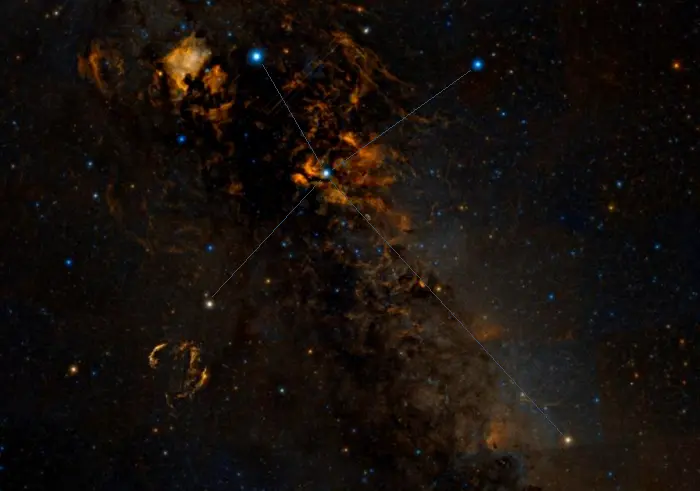
The Northern Cross in the constellation Cygnus, image: Wikisky
The Northern Cross appears in a rich Milky Way field and can be used as a guide for finding the many bright deep sky objects that lie in this area of the sky. These include the North America Nebula (NGC 7000), the Pelican Nebula (IC 5070), the Sadr Region (IC 1318), the Crescent Nebula (NGC 6888), the Veil Nebula (Caldwell 33 and 34), and the open clusters Messier 29 and Messier 39.
Constellation
The Northern Cross is the most visible part of the constellation Cygnus, the Swan. The five stars that form the asterism also outline the body of the celestial Swan. Albireo marks the beak, Deneb the tail, Sadr the chest, and Aljanah and Fawaris the wings. The star pattern gives Cygnus the appearance of a large cross in the sky.
Cygnus is one of the largest and most recognizable constellations in the northern celestial hemisphere. It lies on the plane of the Milky Way and hosts some of the richest star fields in the northern sky. The constellation is known for its bright nebulae and star clusters, as well as for being home to the variable supergiant Deneb, the 19th brightest star in the sky.
The Swan is one of the 48 ancient constellations listed by the Greco-Roman astronomer Claudius Ptolemy in his Almagest in the 2nd century CE. In Greek mythology, it is associated with the story of Zeus’ seduction of Leda in the guise of a swan, as well as with the tragic musician Orpheus, who was transformed into a swan after meeting his end at the hands of the Bacchantes. A different myth links Cygnus with Cycnus (or Cygnus), a king of Liguria who was a close friend of Phaethon, the son of Helios. Phaethon met his end after attempting to drive the Sun god’s chariot across the sky. It is said that his friend mourned him, and the gods transformed Cycnus into a swan to relieve him of his sorrow.
Cygnus is visible from most inhabited locations on Earth for at least part of the year. The entire constellation can be seen from locations north of the latitude 40° S.
Stars
The five bright stars that form the Northern Cross are Deneb (Alpha Cygni), Sadr (Gamma Cygni), Aljanah (Epsilon Cygni), Fawaris (Delta Cygni), and Albireo (Beta Cygni).
All five stars have already evolved away from the main sequence and entered the final stages of their life cycles. The supergiants Deneb and Sadr are supernova candidates, while the other three stars will end their lives as white dwarfs surrounded by planetary nebulae.
Deneb, the brightest of the five stars, is by far the most distant and luminous, as well as the largest and most massive. With an absolute magnitude of -8.38, it is one of the most luminous stars known.
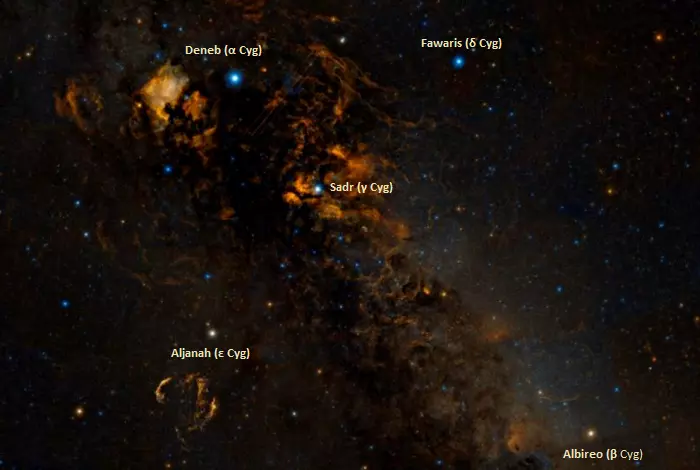
Northern Cross stars, image: Wikisky
| Star | Deneb | Sadr | Aljanah | Fawaris | Albireo |
| Bayer designation | α Cygni | γ Cygni | ε Cygni | δ Cygni | β Cygni |
| Spectral type | A2 Ia | F8 Iab | K0 III | A0 IV | K2 II |
| Apparent magnitude | 1.25 | 2.23 | 2.480 | 2.87 | 3.21 |
| Distance | 2,615 ± 215 ly | 1,800 ly | 72.7 ± 0.2 ly | 165 ± 4 ly | 430 ± 20 ly |
| Mass | 19 ± 4 M☉ | 12.11 ± 0.71 M☉ | 2 M☉ | 2.93 M☉ | 5.2 M☉ |
| Radius | 203 ± 17 R☉ | 150 ± 80 R☉ | 10.82 ± 0.14 R☉ | 5.13 R☉ | 62 R☉ |
| Luminosity | 196,000 ± 32,000 L☉ | 33,023 L☉ | 62 ± 3 L☉ | 155 L☉ | 1,259 L☉ |
| Temperature | 8,525 ± 75 K | 5,790 ± 100 K | 4,710 K | 10,150 K | 4,383 K |
Deneb
Deneb (Alpha Cygni), the star at the top of the Northern Cross, is the brightest star in Cygnus and the 19th brightest star in the sky. It is a blue-white supergiant of the spectral type A2 Ia. With a surface temperature of 8,525 K, it is about 196,000 times more luminous than the Sun. The star marks the tail of the celestial Swan.
The supergiant is by far the most distant first-magnitude star. In fact, it is the most distant of the 35 brightest stars by a factor of almost 2. It shines at magnitude 1.25 from a distance of 2,615 light-years. Among the 300 brightest stars in the sky, only Almaaz (Epsilon Aurigae) and Omicron2 Canis Majoris may be more distant. They are located approximately 3,300 and 2,800 light-years away respectively, but these values are uncertain and have large margins of error.
The name Deneb is derived from the Arabic dhaneb, meaning “tail.” Alpha Cygni was also traditionally known as Arided and Aridif, but these names have fallen out of use.
Deneb is one of the vertices of the Summer Triangle. It forms the asterism with the brighter Vega in the constellation Lyra and Altair in Aquila. Vega and Altair appear brighter only because they lie in the solar neighbourhood. Altair is only 16.73 light-years away and Vega, 25.04 light-years away.
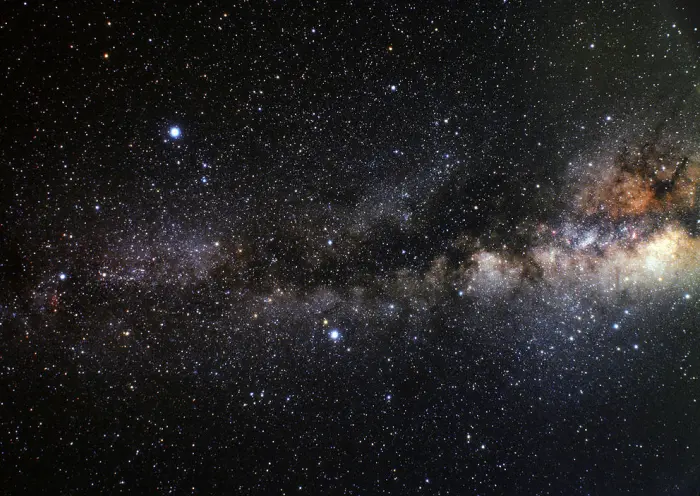
The Summer Triangle and the Northern Cross — Deneb is visible in the centre-left part of the image, Vega appears top left, and Altair near the centre. The Great Rift of the Milky Way runs through the image. Credit: NASA, ESA, A. Fujii
With a mass 19 times that of the Sun, Deneb is a supernova candidate. Even though it is a young star, it has evolved quickly due to its high mass and will meet its end within only millions of years.
Deneb is a prototype for a class of variable stars known as the Alpha Cygni variables. Its brightness varies from magnitude 1.21 to 1.29 due to non-radial pulsations. Stars in this class are typically A and B-type supergiants with pulsation periods of several days to several weeks. They vary in brightness because some parts of their surfaces are expanding while others simultaneously contract. Bright Alpha Cygni variables include the supergiants Rigel and Alnilam in Orion, Aludra in Canis Major, Kappa Cassiopeiae in Cassiopeia, and Rho Leonis in Leo.
Sadr
Sadr (Gamma Cygni), the star at the centre of the Northern Cross, is a yellow-white supergiant of the spectral type F8 Iab. It shines at magnitude 2.23 from a distance of 1,800 light-years. It is the second brightest star in Cygnus. The name Sadr is derived from the Arabic word şadr, meaning “chest.” It refers to the supergiant’s position in Cygnus, at the Swan’s chest.
Sadr has 12.11 times the Sun’s mass and a radius 150 times solar. It is massive enough to be a supernova candidate. With an effective temperature of 5,790 K, it shines with 33,023 solar luminosities. The star has an estimated age of only 12 million years but, like Deneb, it is already in the final stages of its life.
Sadr is surrounded by a diffuse emission nebula called the Sadr Region or the Gamma Cygni Nebula. The nebula is catalogued as IC 1318.
Aljanah
Aljanah (Epsilon Cygni) is an orange giant of the spectral type K0 III. With an apparent magnitude of 2.480, it is the third brightest star in Cygnus. It lies 72.7 light-years away and is the nearest of the five stars of the Northern Cross, as well as the least massive. Aljanah has a mass twice that of the Sun and a radius 10.82 times the Sun’s. It is 62 times more luminous than our star, with a surface temperature of 4,710 K.
The name Aljanah comes from the Arabic janāħ, meaning “wing.” The star marks one of the Swan’s wings (the other is marked by Fawaris) and was traditionally also known as Gienah. The names Gienah and Aljanah have the same etymology. Epsilon Cygni shared both names with Gamma Corvi, the star that marks the wing of the celestial Crow (Corvus). To distinguish between them, the two stars were sometimes called Gienah Cygni and Gienah Corvi. Gamma Corvi is now formally known as Gienah.
Aljanah has a spectroscopic companion, a visual companion, and another proper motion companion at a separation of 78 arcseconds. The spectroscopic binary pair has an orbital period of at least 15 years. The more distant companion is a 13th magnitude star at a separation of at least 1,700 astronomical units. The two stars orbit each other with a period of at least 50,000 years.
Fawaris
Fawaris is the hottest of the five stars that form the Northern Cross. It has a surface temperature of 10,150 K and is 155 times more luminous than the Sun. It is a blue giant star of the spectral type B9. Like other Northern Cross stars, it has already come to the end of its main sequence lifetime.
Fawaris shines at magnitude 2.87 from a distance of 165 light-years. It is the fourth brightest star in Cygnus.
The star has a mass of 2.93 solar masses and a radius 5.13 times that of the Sun. It is a very fast spinner. With a projected rotational velocity of 135 km/s, it spins about 60 times faster than the Sun.
Fawaris is part of a triple star system. The closer companion, Delta Cygni B, is a class F main sequence star with a visual magnitude of 6.33, about 6 times more luminous than the Sun. The two stars orbit each other with a period of 780 years at an average separation of 157 astronomical units. Together they have the spectrum of an A0 IV-type star.
The more distant companion is a 12th magnitude class K star.
The name Fawaris is derived from the Arabic al-Fawāris, meaning “the Riders.” It refers to the Arabic asterism of the same name, which was formed by Delta, Zeta, Epsilon, and Gamma Cygni.
Albireo
Albireo (Beta Cygni), the star at the base of the Northern Cross, is an orange bright giant of the spectral type K2II. Shining at magnitude 3.21, it is the faintest of the five stars that form the Northern Cross. Even though it has the designation Beta, it is not as bright as Gamma, Delta, and Epsilon Cygni (Sadr, Fawaris, and Aljanah). Albireo lies about 430 light-years away and marks the beak of the Swan.
Beta Cygni is one of the finest double stars in the night sky, with contrasting blue and yellow components, sometimes described as sapphire and gold.
Albireo, the primary component, appears as a single star to the unaided eye but is part of a triple star system. Telescopes reveal a visual double star, the orange giant and a fainter hot blue main sequence star. The two visual components – Albireo A and Albireo B – are separated by 35 arcseconds. It is uncertain whether they form a physical pair or just lie in the same line of sight. If they are physically bound, they probably take at least 100,000 years to complete an orbit. The Beta Cygni system can easily be resolved in large binoculars and small telescopes.
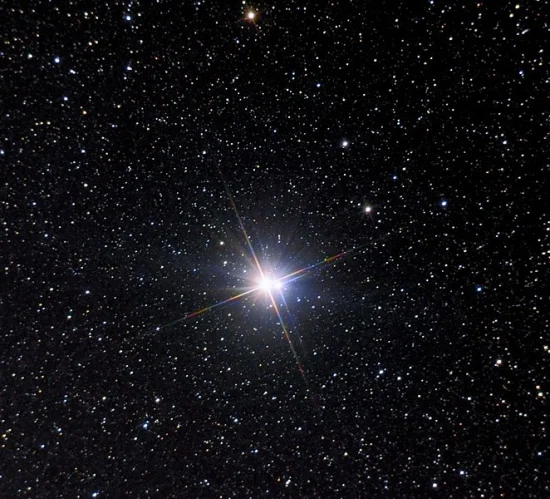
Albireo, image credit: Henryk Kowalewski (CC BY-SA 2.5)
Albireo A is itself a binary star. The two components, Albireo Aa and Albireo Ac, orbit each other with a period of 121.65 years and are separated by only 0.401 arcseconds.
All three stars are larger and more massive than the Sun. Albireo Aa has a mass 5.2 times that of the Sun and a radius 62 times solar. It shines with 1,259 solar luminosities with a surface temperature of 4,383 K.
Albireo Ac has a mass of 2.7 solar masses and a radius three times that of the Sun. Its energy output is 79 times that of our star with an effective temperature of 10,000 K.
Albireo B is 3.7 times massive and 2.59 times larger than the Sun. It is the hottest and most luminous of the three stars. With an effective temperature of 13,200 K, it shines with 230 solar luminosities. The star has an estimated age of 100 million years.
The origin of the name Albireo is uncertain, but the name is believed to be a result of mistranslation. It is thought to have come from the Greek name for the constellation Cygnus, which was ornis (“bird”). The name became urnis in Arabic. When the Arabic term was translated into Latin, it was mistakenly believed to refer to the plant Sisymbrium officinale (formerly Erysimum officinale), and was translated as ireo, which was the Latin name for the plant. Later, the phrase ab ireo was transcribed as al-bireo because it was treated as a misprint of an Arabic term.
Medieval Arabic astronomers called Beta Cygni minqār al-dajājah, meaning “the hen’s beak.” This name was translated into Latin as Rostrum Gallinǣ.
How to find the Northern Cross
The Northern Cross is easy to find because the stars that form it are quite bright and visible even from light-polluted areas. For northern observers, the asterism is visible for most of the year at some point in the night.
Cygnus constellation culminates at midnight on June 29. The pole of the Northern Cross appears within the larger Summer Triangle asterism. The Summer Triangle is formed by Deneb with Altair in the constellation Aquila and Vega in Lyra.
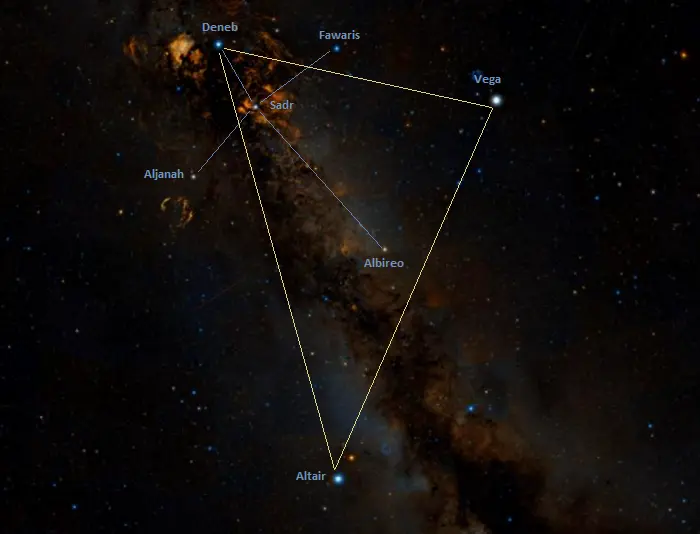
The Northern Cross and the Summer Triangle, image: Wikisky
In January, the Northern Cross makes an appearance above the northwestern horizon around 8 pm and is briefly visible in the northeast just before dawn.
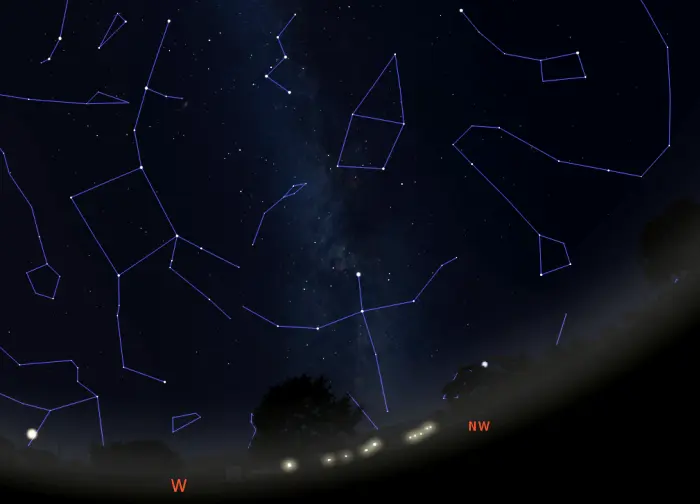
The Northern Cross in January, image: Stellarium
In April, it rises in the northeastern sky around 2 am, appearing parallel to the horizon, and reaches zenith before dawn.
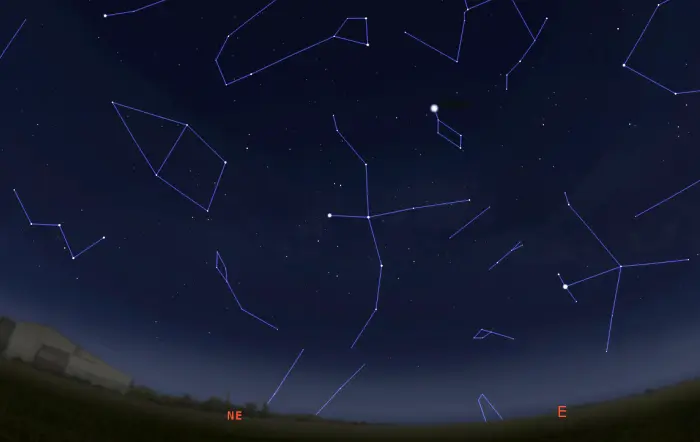
The Northern Cross in April, image: Stellarium
In July, it rises early in the evening and is high above the horizon by 10 pm, appearing overhead after midnight.
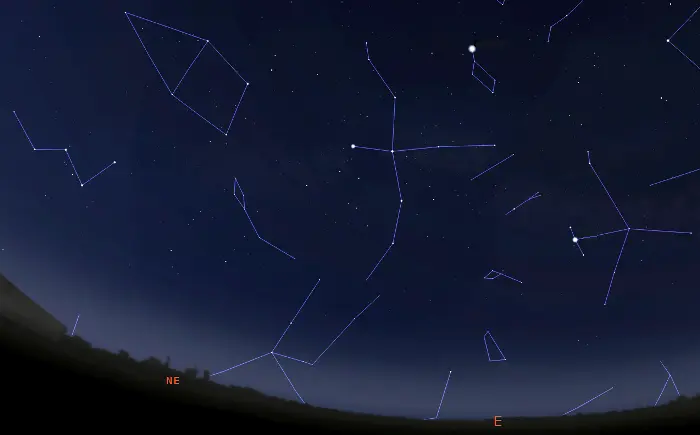
The Northern Cross in July, image: Stellarium
In October, it is high in the sky by nightfall and sets in the northwestern sky around 4 am.
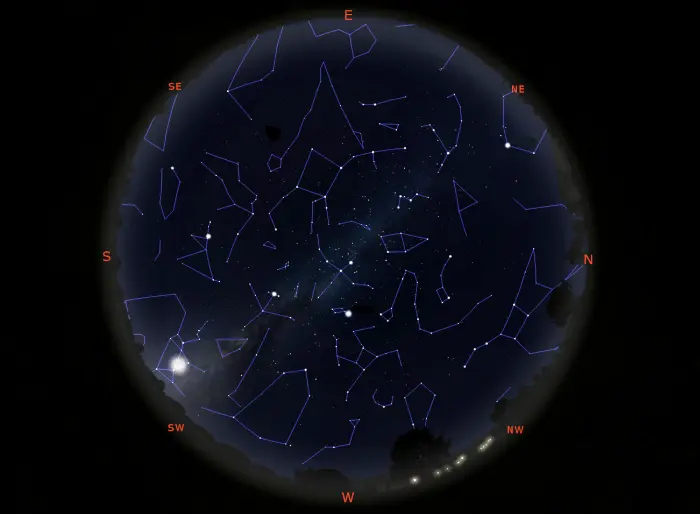
The Northern Cross in October, image: Stellarium
The best time of the year to see the Northern Cross is during the month of September when it is high overhead after sunset and makes its way across the sky during the night. The asterism is circumpolar north of the latitude 45° N. It never falls below the horizon and can be seen throughout the year.
For observers in the southern hemisphere, the Northern Cross never rises very high above the horizon and it appears upside down. It can be seen low in the sky during the winter months.
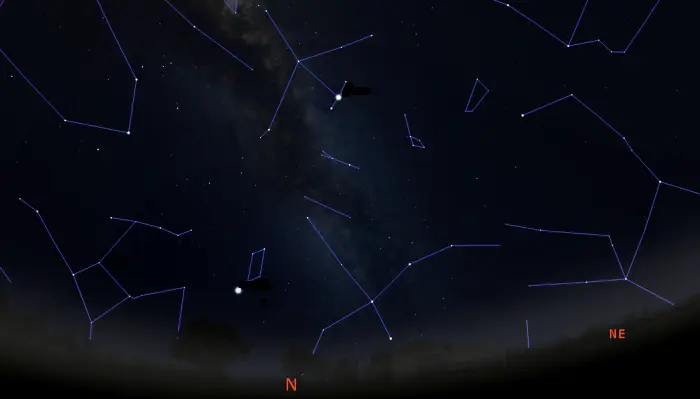
The Northern Cross as seen from the southern hemisphere, image: Stellarium
How to find north with the Northern Cross
The Northern Cross can be used to find Polaris, the star that marks the north celestial pole. A line extended from Aljanah through Deneb points in the direction of the North Star.
Polaris is also easily found using the Pointer Stars in the Big Dipper. The outer stars of the Dipper’s bowl, Merak and Dubhe, point toward Polaris and the north celestial pole.
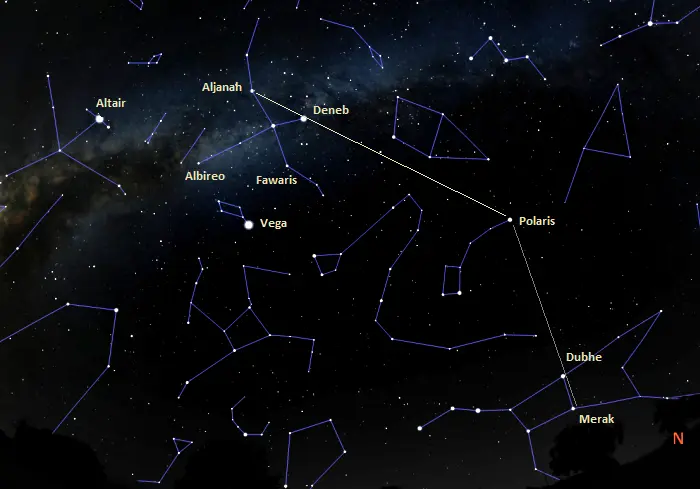
The Northern Cross, the Big Dipper and the north celestial pole, image: Stellarium
Constellations near the Northern Cross
The Northern Cross can be used to find the less conspicuous constellations that lie in the same region of the sky. The constellation Cygnus borders Pegasus to the southeast, Lacerta to the east, Cepheus and Draco to the north, Lyra to the west, and Vulpecula to the south.
Pegasus stands out in the sky because its bright stars form a prominent asterism called the Great Square of Pegasus. The supergiant Enif, the brightest star in Pegasus, is not part of the Great Square. It can be located by extending a line through the beam of the Northern Cross.
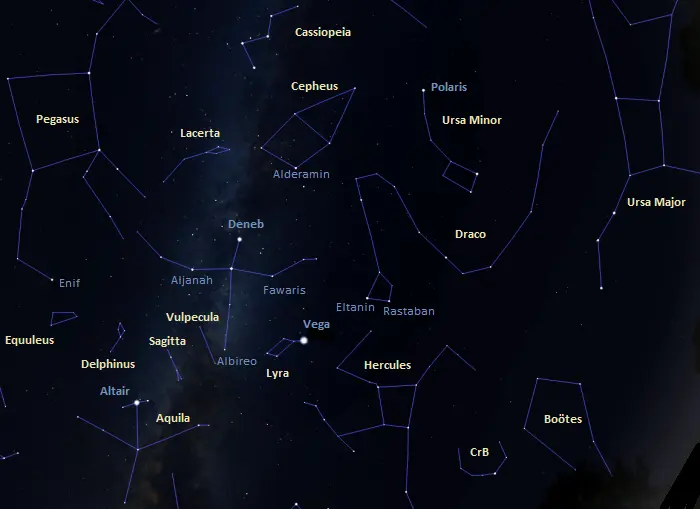
The constellations near the Northern Cross, image: Stellarium
Extending the line in the opposite direction leads to the Head of Draco. The two brighter stars in the Dragon’s head, Eltanin and Rastaban, lie along this imaginary line. They mark the Dragon’s eyes. The body of Draco extends almost parallel to the beam of the Northern Cross in the direction of Cepheus and then winds around the bowl of the Little Dipper in Ursa Minor, ending between the Big and Little Dippers.
Cepheus occupies much of the space between the Northern Cross and the W of Cassiopeia. Its stars are not particularly bright, but they form a distinctive stick house pattern that makes the constellation recognizable.
The faint Lacerta (the Lizard) is a faint constellation recognizable for a W shape similar to that of Cassiopeia. The star pattern can be found along the imaginary line extended from Fawaris through Deneb.
Lyra and Aquila are easy to identify because their brightest stars, Vega and Altair, form the Summer Triangle with Deneb. Vega, the fifth brightest star in the sky, appears next to a parallelogram pattern that represents the celestial Harp. Altair, the 12th brightest star in the sky, is flanked by two other relatively bright stars, Tarazed and Alshain. The bird-like constellation pattern of Aquila is easy to make out because the celestial Eagle flies opposite the Swan.
The faint Vulpecula (the Fox) appears near Albireo, in the centre of the Summer Triangle. It hosts the Coathanger (Brocchi’s Cluster), an asterism formed by about 10 stars, best seen in binoculars. The small but distinctive Sagitta is found about halfway between Albireo and Altair, and the easily recognizable Delphinus appears in the region between Albireo and Enif.
Deep sky objects near the Northern Cross
The region of the Northern Cross is populated by several bright nebulae and star clusters that can be found using the five bright Cygnus stars.
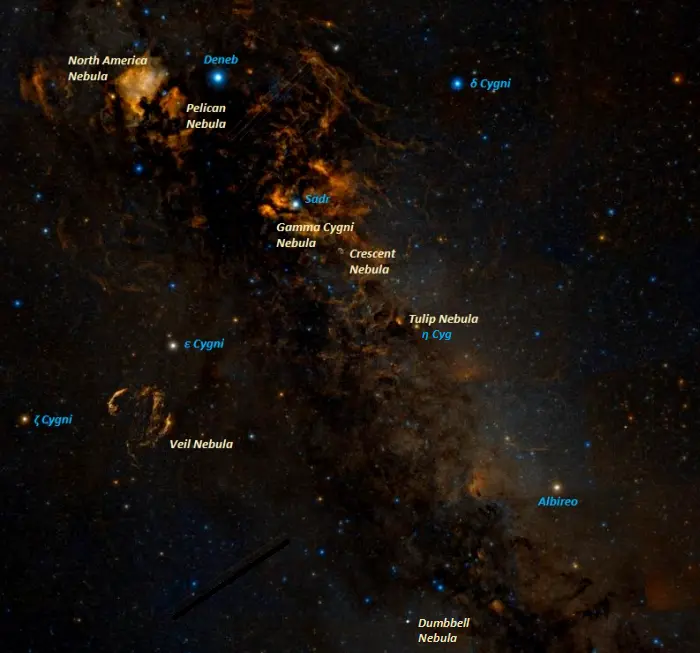
The nebulae near the Northern Cross, image: Wikisky
Deneb appears close to the North America Nebula (NGC 7000) and the Pelican Nebula (IC 5070). The two large emission nebulae are separated by a dark dust lane. The North America Nebula stretches across an area more than 10 times that of the full Moon. Even though it has an apparent magnitude of 4, its low surface brightness makes it a challenging target from light-polluted areas. The neighbouring Pelican Nebula is considerably fainter with an apparent magnitude of 8.0. The two nebulae are part of the larger H II region Westerhout 40.
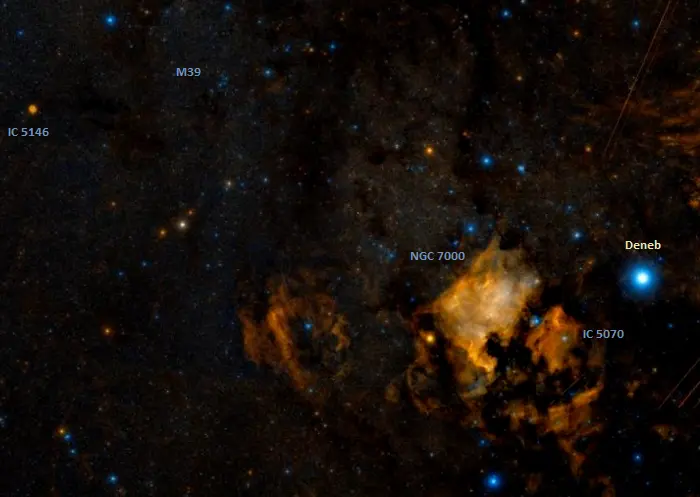
Deneb, Messier 39, Cocoon Nebula, North America Nebula and Pelican Nebula, image: Wikisky
The supergiant can also be used to find the bright open cluster Messier 39, which appears about 9 degrees east and a little north of the star. The Cocoon Nebula (IC 5146), a reflection/emission nebula, lies in the same area, near the star Pi Cygni.
Sadr appears surrounded by a diffuse nebula called the Sadr Region or the Gamma Cygni Nebula. Catalogued as IC 1318, the double-lobed nebula is sometimes called the Butterfly Nebula. (It shares the name with NGC 6302 in the constellation Scorpius.) The Sadr Region contains both emission nebulae and dark nebulae. It lies much farther away than Sadr and is unrelated to the star. The nebula is illuminated by a luminous blue O-type star.
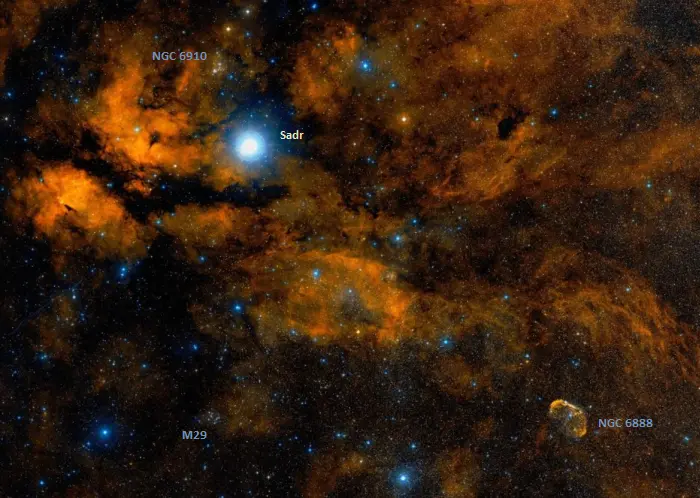
Sadr, the Gamma Cygni Nebula, the Rocking Horse Cluster, the Crescent Nebula and Messier 29, image: Wikisky
The open cluster NGC 6910, popularly known as the Rocking Horse Cluster, appears about half a degree east and a little north of Sadr.
The Crescent Nebula (NGC 6888), an emission nebula formed by the stellar wind of a Wolf-Rayet star, lies about 2 degrees southwest of Sadr. The bright open cluster Messier 29 is found 1.7 degrees south and a little east of the star.
Fawaris can be used to find the open cluster NGC 6811. The cluster appears northeast of the star. It is sometimes called “The Hole in the Cluster” because it has a dark centre.
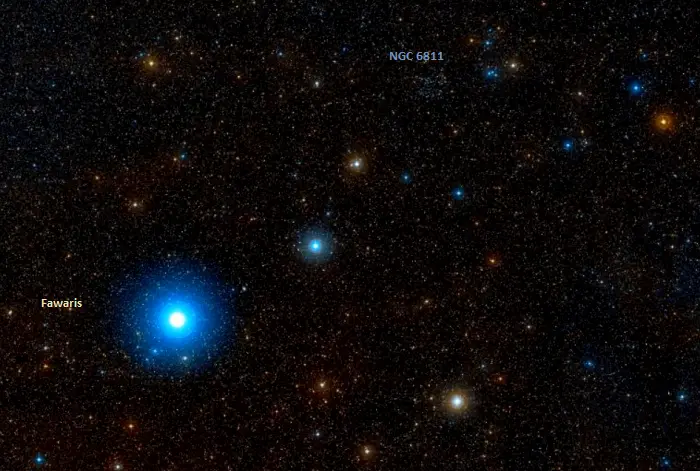
Fawaris and NGC 6811, image: Wikisky
Aljanah serves as a guide to the Veil Nebula, the visible part of the Cygnus Loop, a vast remnant of a supernova that occurred between 10,000 and 20,000 years ago. The nebula takes up much of the space within the triangle formed by Aljanah and the relatively bright Zeta Cygni and 41 Cygni. Its three main visual components – the Eastern Veil, the Western Veil, and Pickering’s Triangle – are popular astrophotography targets. The entire nebula is 3 degrees across. Its diameter is 6 times that of the full Moon.
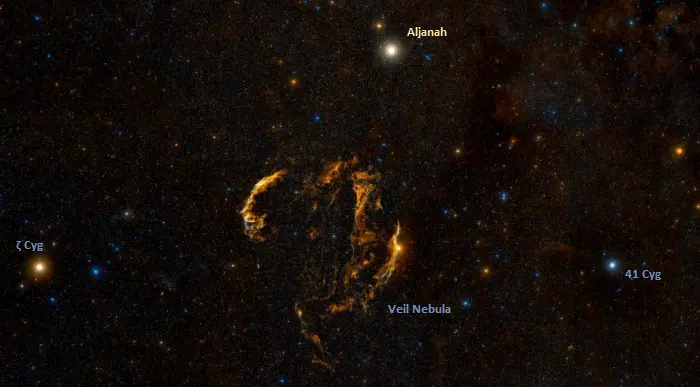
Aljanah and the Veil Nebula, image: Wikisky
Eta Cygni can be used to find the Tulip Nebula, the open cluster NGC 6871, and the X-ray source Cygnus X-1. The class K giant lies about halfway between Sadr and Albireo and forms the lower part of the Northern Cross with them. It shines at magnitude 3.89 and is sometimes considered to be the sixth star of the Northern Cross.
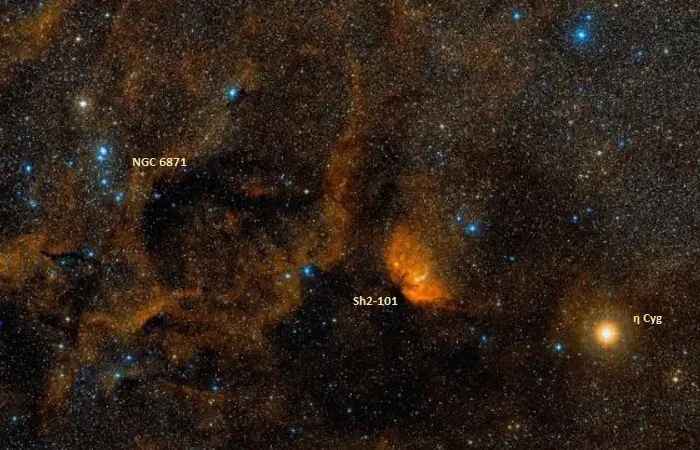
Eta Cygni, the Tulip Nebula and NGC 6871, image: Wikisky
The Tulip Nebula is an emission nebula with an apparent magnitude of 9.0 and an apparent size of 16 by 9 arcminutes. It lies in the same line of sight as Cygnus X-1, a galactic X-ray source believed to be a black hole that forms an X-ray binary system with a variable blue supergiant. The open cluster NGC 6871 is small but bright with an apparent magnitude of 5.2. It appears a bit further away from Eta Cygni than the Tulip Nebula.
Albireo can be used to find two bright Messier objects. The globular cluster Messier 56 in Lyra appears roughly halfway between Albireo and Sulafat (Gamma Lyrae), the slightly brighter of the two stars at the base of the parallelogram asterism that makes the constellation Lyra easily identifiable. Messier 56 shines at magnitude 8.3 from a distance of 32,900 light-years.
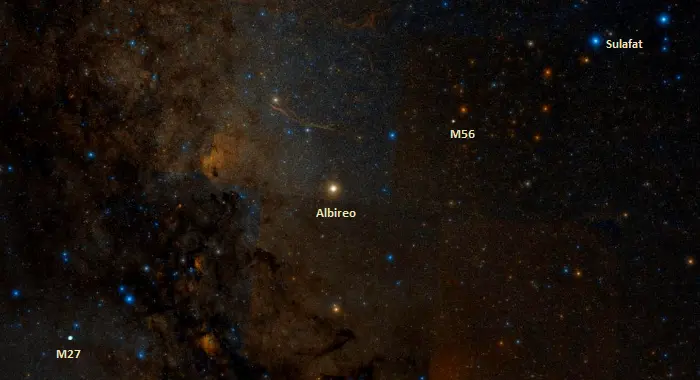
Albireo, Messier 56 and the Dumbbell Nebula (Messier 27), image: Wikisky
The Dumbbell Nebula (Messier 27) is one of the brightest planetary nebulae in the sky, shining at magnitude 7.4. It appears between Albireo and the constellation figure of Delphinus, near the tip of the celestial Arrow (Sagitta). The nebula is visible in binoculars and small telescopes.
Facts
Deneb and Fawaris are members of a group of northern stars that take their turn as the North Star during the Earth’s 25,770-year precession cycle. Deneb is by far the brightest of the north pole stars, but the least accurate marker of true north. It only comes within 7 degrees of the north celestial pole. In comparison, Polaris, the current North Star, comes within 0.5 degrees of the pole.
Deneb will become the North Star around the year 10,200 CE, succeeding Alderamin in the constellation Cepheus. Fawaris will take over the title in 11,600 CE. While it is considerably fainter than Deneb, it will come within 3 degrees of the pole and be a more accurate pole star. Fawaris will be succeeded by Vega in the constellation Lyra in 13,700 CE.
Deneb marks one end of the Great Rift, a dark band of dust clouds that obscure the centre and most radial sectors of the Milky Way from our perspective. The dark clouds stretch from the Northern Coalsack nebula near Deneb past the Galactic centre in Sagittarius all the way to Centaurus in the far southern sky. The dark lane appears to divide the Milky Way’s bright band vertically and covers a third of it.

The Great Rift in a panorama of the Milky Way galactic plane stretching over Bontecou Lake in Dutchess County, New York — Vega is the bright star near the top of the image. Credit: Wikimedia Commons/Juliancolton (CC BY-SA 4.0)
In Greek mythology, the Great Rift was sometimes associated with the path of Phaethon, who lost control of the Sun god’s chariot and left a trail of devastation before being struck down by Zeus.
The Northern Cross has symbolic meaning to Christians because every year around Christmas it sits upright on the northwest horizon for observers in northern latitudes.
In Chinese and Japanese mythology, the band of the Milky Way between Deneb and Albireo separates two lovers, the Cowherd (Niulang) and the Weaver Girl (Zhinü), represented by the bright stars Altair and Vega. The lovers are banished to opposite banks of a river (the Milky Way) and only allowed to meet once a year, when magpies form a bridge across the river. In some versions of the tale, Deneb represents a fairy that chaperones the lovers when they meet.